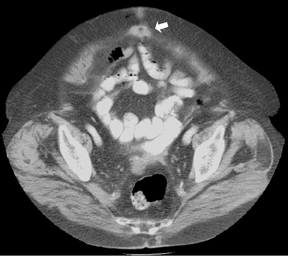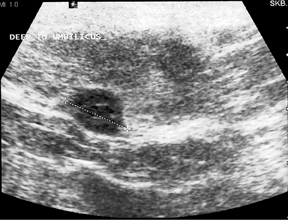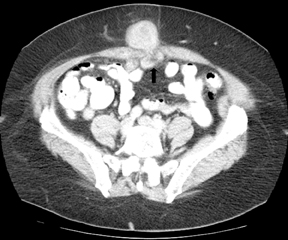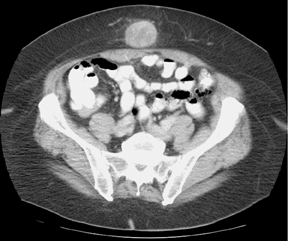Sister Joseph’s nodule: Imaging of a clinical sign
Images





Sister Joseph’s nodule (metastatic disease to the umbilical region)
Findings
Case 1: CT of the abdomen with oral and intravenous contrast revealed a large metastatic deposit in right lobe of the liver (Figure 1).Additionally an enhancing nodule was seen involving the rectus sheath at the level of the umbilicus (Figure 1).
US showed a hypoechoic lesion, measuring 1.4 x 1.0 cm, deep to the umbilicus (Figure 2). This corresponds to the nodule seen in Figure 1B.
Case 2: Axial CT section taken at the level of umbilicus showed a 4.5 x 4 cm, well defined enhancing dumbbell shaped mass in the anterior abdominal wall involving the subcutaneous fat planes. It appeared to be arising from the peritoneum (Figure 3). Distal to the umbilicus another well-circumscribed enhancing nodule was seen lying within the subcutaneous tissue of the anterior abdominal wall(Figure 3). There was no evidence of recurrence of the primary tumor.
Discussion
Metastatic umbilical nodules are known as Sister Joseph’s nodules (SJN), named after the brilliant first assistant to Dr. W.J. Mayo of theMayo Clinic. The presence of an umbilical metastasis indicates a poor prognosis and is a sign of advanced neoplastic disease.1 These deposits usually arise from primary tumors of the gastrointestinal tract, pancreas, and ovary. Other primary sites include breast, gall-bladder, liver,and the endometrium. Histologically most nodules are adenocarcinomas although squamous cell carcinoma, carcinoid, and lymphoma have also been reported.2
SJNs present as a painful fibrous periumbilical lump, usually 0.5 to 2 cm in diameter, although some can grow as large as 10 cm.Whilst it remains a finding on clinical examination, imaging investigations, such as US and CT, aid in differentiating these from a variety of umbilical disorders, such as umbilical hernia, umbilical endometriosis, papilloma, foreign body granuloma, epidermoid cyst, omphalith, and primary carcinoma.3 Additionally, owing to the increasing number of cross-sectional imaging performed in patients under evaluation for malignancies, the radiologist may be the first to diagnose a periumbilical nodule.
SJNs are seen on US as hypoechoic masses with varying degrees of definition.4 On contrast CT they have been reported to appear as solid well-defined, enhancing lesions encompassing 3 forms: subcutaneous nodule, dermal deposits, or peritoneal mass extending into the anterior abdominal wall.5
Real-time scanning of the nodule on US can provide easy access for biopsy or fine needle aspiration cytology. This has been reported as a safe and reliable diagnostic tool to establish diagnosis and guide further management.6
Conclusion
SJN are metastatic deposits in the periumbilical region. US and CT aid in differentiating these from other umbilical conditions.Their superficial location makes them an attractive target for diagnostic biopsy or fine needle cytology.
- Gabriele R, Conte M, Egidi F, Borghese M. Umbilical metastases: Current viewpoint. World J Surg Oncol. 2005;21;13.
- Tam C, Turner H, Hicks RJ, Seymour JF. Diffuse large B-cell non-Hodgkin’s lymphoma presenting as Sister Joseph’s nodule. Leuk Lymphoma. 2002;43:2055-2057.
- Grunewald B, Viggiano J, Chapman E. Widespread intraabdominal carcinoid tumor presenting as an umbilical metastasis: Diagnosis by fine-needle aspiration. Diagn Cytopathol. 1996;15:457-458.
- Ching AS, Lai CW. Sonography of umbilical metastasis (Sister Mary Joseph’s nodule): From embryology to imaging. Abdom Imaging. 2002;27:746-749.
- Coll DM, Meyer JM, Mader M, Smith RC. Imaging appearances of Sister Mary Joseph nodule. Br J Radiol. 1999;72:1230-1233.
- Sahai K, Kapila K, Verma K. Fine-needle aspiration cytology of umbilical nodules: “Sister Joseph’s nodule.” Diagn Cytopathol. 2001;25:309-310.
Related Articles
Citation
Sister Joseph’s nodule: Imaging of a clinical sign. Appl Radiol.
April 27, 2012